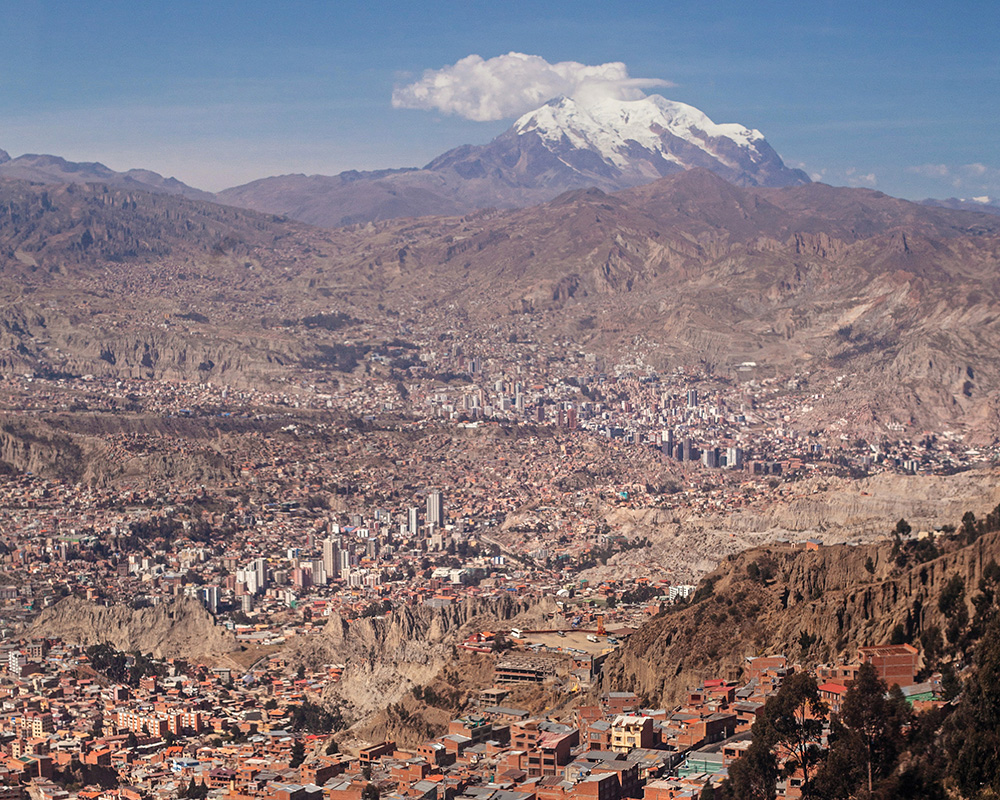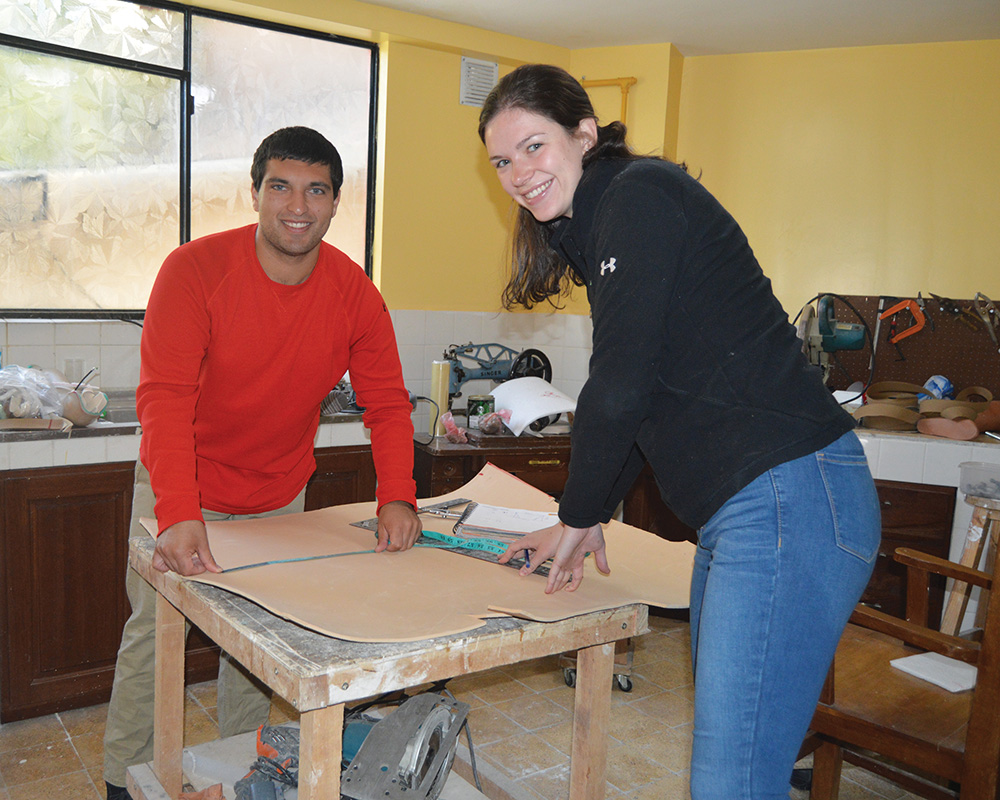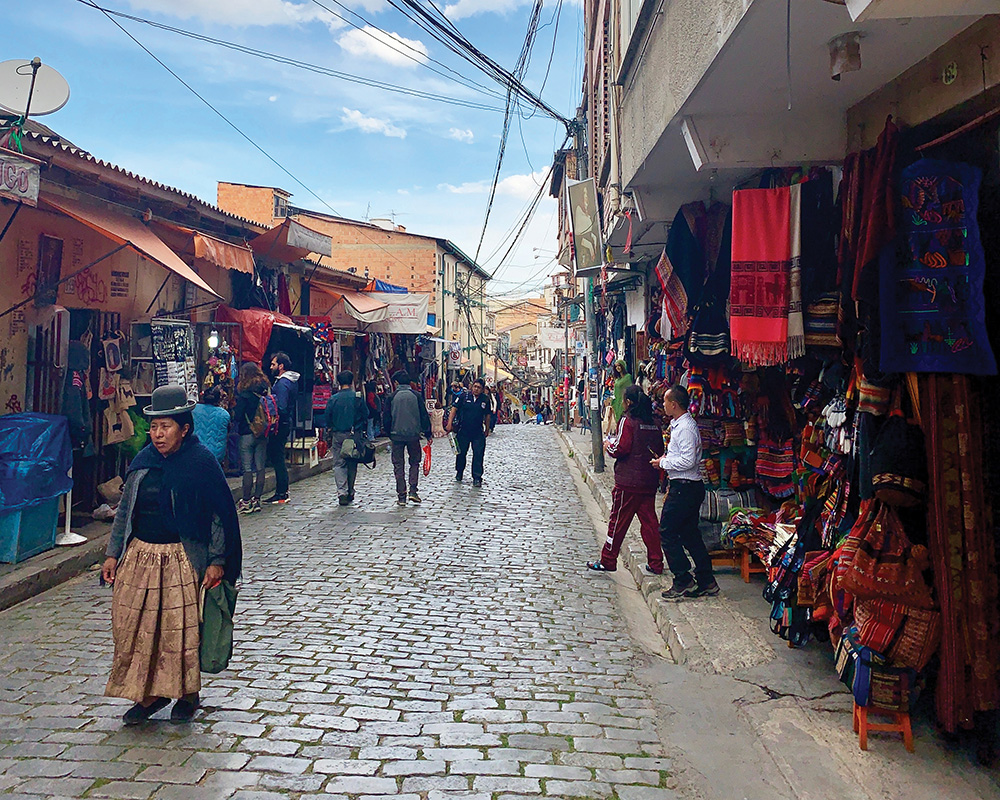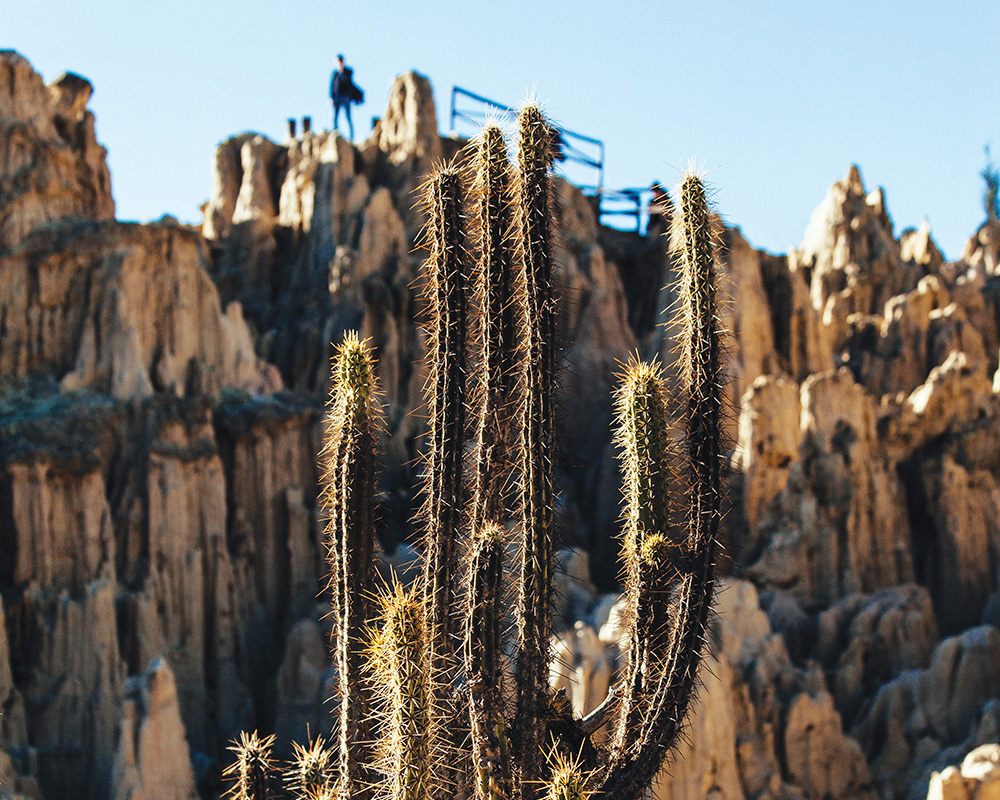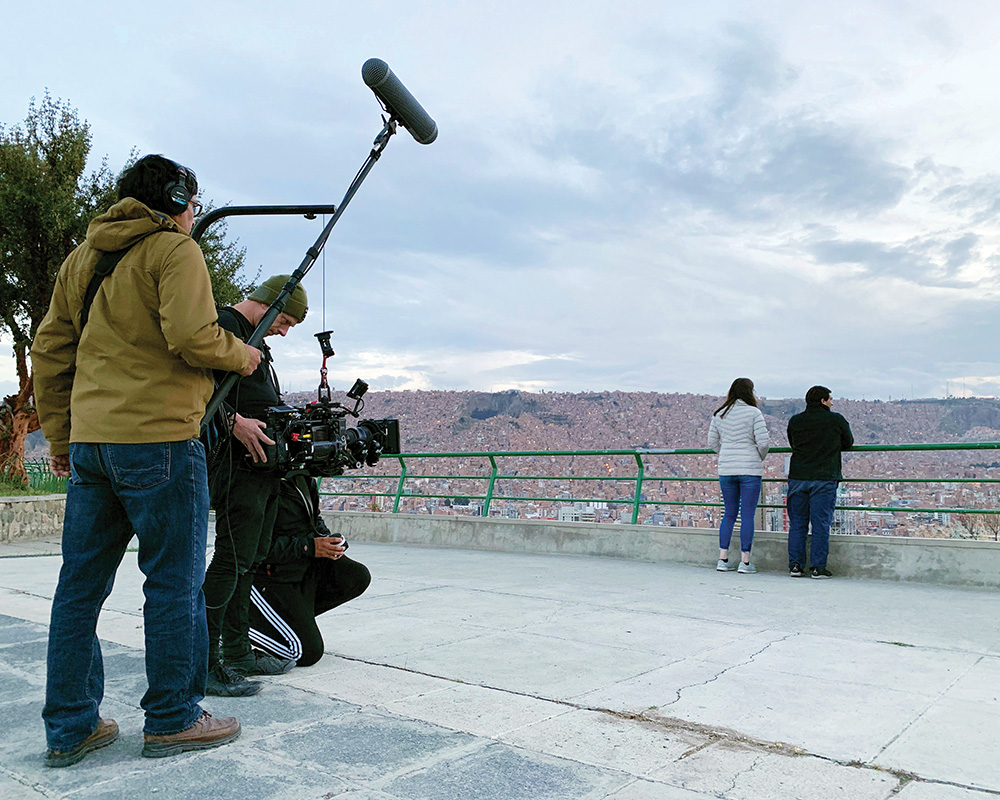Andes dreams come true
In the South American nation of Bolivia, known for its high mountains and colorful culture, the view students Ellen Lucchesi and Michael Fornadel saw most frequently was the bright yellow and red paint on the walls of their box-like workshop.
But what they saw happen inside that workshop was infinitely more stunning: Shapeless materials being molded into the form of a leg or foot. Lifeless plastic that would soon restore mobility, independence and dignity to someone after the loss of a leg.
“After watching the guys in the workshop using these little handsaws and tools on something that came out of what looked like an oversized Easy-Bake Oven was amazing,” said Lucchesi, who graduated in December with her degree in mechanical engineering. “Sometimes simpler solutions work, and I think it’s important for us to remember that as engineers.”
For 19 years, UD students like Lucchesi and Fornadel have been providing research, expertise and helping hands during technical immersions around the globe through ETHOS, Engineers in Technical Humanitarian Opportunities of Service. Students work with communities to improve lives through local, innovative solutions. It’s a way for the University to educate ethical, smart engineers, but it’s also an opportunity for the students to grow and stretch in ways they didn’t know were possible.
The experience gave Lucchesi and Fornadel a glimpse into how the knowledge and skills they acquired at UD can be applied in ways that make a real difference in a very personal way — like replacing a lost limb. They also learned how being an engineer can have a real impact on their lives when using their talents to serve others. During their 10 weeks in La Paz, Bolivia, it was about being patient, mindful, compassionate and perceptive, traits that allowed them to learn to build prosthetics along with the trust of their patients. It was also about feeling a bit like a movie star. And thanks to that fame, they’re sharing the ETHOS model with the world.
The engineers
The ETHOS program in the School of Engineering looks at the skill sets of students and then matches them to locations in need of those abilities. The Funprobo prosthetics clinic in La Paz was a great fit for two of last summer’s students. The nonprofit organization provides prosthetics to people with limited resources who have lost one or both lower extremities. The small staff hosts volunteers from all over the world who donate their time and talent to the people of La Paz. Clinic staff are grateful for the support, but as Fornadel said, it’s often the volunteers who gain the most from the experience.
“Before getting to the clinic, we thought of prosthetics as being these high-tech things made of flexible metals or polymers or titanium, but we saw in La Paz that more traditional prosthetics — the kind made of plastic and painted to be flesh-tone — were just as effective,” said Fornadel, who graduated in December with his degree in mechanical engineering. “As engineers, sometimes we try to make things more complex, more advanced. That’s not necessarily a bad thing, but it also might lead to more unnecessary problems.”
Day-to-day activities at the clinic covered a lot of ground. At times it was fixing broken furniture or cleaning up around the workshop. Sometimes they organized the office, prepped the clinic for patients or looked at ways to streamline processes. Or it might be helping mold plastic to form legs. Clinic staff were updating the Funprobo website, so the students pitched in by recording patient testimonials and adding photos to Funprobo’s Facebook page to further promote the clinic.
Because of the cultural norms in Bolivian society, patient interaction was limited and dictated by gender most of the time. Men weren’t permitted to be present when a female patient was being measured for a device or fitted to avoid making her uncomfortable. Lucchesi was able to work hands-on with some of the female patients and assisted with their rehab, but typically the students observed clinic staff during these sessions, helping out when asked. These observations were eye-opening, Lucchesi said. To see a child kick a soccer ball for the first time, or a mother be able to care for her children more independently, gave the students a personal revelation of how engineering can fulfill dreams and touch lives in positive ways.
“I’ve always had an interest in medicine,” Lucchesi said. “My mom is a nurse so maybe that’s why, but I knew medical school or nursing wasn’t for me. My love of math drew me to engineering, and the biomechanical faculty at UD really sparked my interests, especially my undergraduate research under assistant professor Tim Reissman. After an internship with a medical device manufacturer and the time spent at Funprobo, I knew this was the career path for me.”
The students also drew great inspiration from the clinic director, Ivonne Chumacero. A schoolteacher by trade, she and her husband, Dante, a doctor, founded the clinic along with help from international relief agencies and the La Paz Rotary. She runs the day-to-day operations while her husband helps out doing patient evaluations. The couple volunteers their time, talent and treasure to support its work. Fornadel was impressed at her achievements despite the male-dominated Bolivian culture.
“Ivonne is a real trailblazer,” he said. “She was the first female member of the La Paz Rotary, she runs the clinic, teaches school and could make one of those legs start to finish by herself. She’s a model of dedication, compassion, resourcefulness and perseverance.”
The movie stars
Not long after Lucchesi and Fornadel landed in Bolivia, an American film crew arrived to chronicle their experience. The video was commissioned by the University to help tell the story of ETHOS — and experiential learning and dedication to the common good — in a more visual way and connect with audiences including prospective students, alumni and higher education opinion leaders.
The three-part documentary series follows the students through their work and life in Bolivia and also provides a larger picture of the mission of the ETHOS program.
“I think in lots of places studying engineering is about getting good grades, getting a good job, finding a good company with a good pay, but I think there’s more to it than that,” says Malcolm Daniels, director of the ETHOS Center, in the video. “Why is it still a problem that people don’t have clean water in lots of places on the planet? Why is it a problem that lots of people die because they cook on open fire in a home that’s unventilated? I think strongly that there’s a solution to these problems and we just have to work hard to find it.”
Soon after arriving in La Paz, Lucchesi and Fornadel started to work with Victor, a former soccer player featured in the videos. But since they didn’t yet have much experience in the clinic, for the cameras they set about looking busy, touching unfamiliar equipment and walking down streets that were nowhere near their apartments or the clinic.
In the streets of La Paz, this entourage drew a lot of attention, as did Lucchesi, who is 6 feet tall. Bolivians as a people are smaller in stature than Americans, so locals thought this tall woman being pampered and filmed must surely be some American starlet. They pointed, smiled and took pictures of their own. Crowds would gather to watch the pair walk down the same street over and over as the crew searched for that perfect shot or waited for a beautiful sunset behind the mountain to frame the students as they stood on a balcony overlooking the bustling city below.
The mini-documentary — watch it above or at udayton.edu/m/ethos.php — is informative, moving and artfully filmed. But 18 minutes cannot tell the whole story or capture the experience of both living and working in Bolivia for 10 weeks.
Lucchesi and Fornadel said that despite the impression that they were staying in the same apartment, they did not. Other college students also serving in La Paz for the summer were housed in two locations, with the men clearly getting the better end of the housing lottery; this was the location for filming their living quarters. The women shared an apartment that was under renovation with an on-again-off-again shower. While the men’s place may have had smaller rooms, it was updated, had a working bathroom and Wi-Fi. It also had a sunroom with a beautiful view of Illimani, the iconic mountain that serves as the backdrop to the city of La Paz.
They also thought the film portrayed Fornadel as a serious, stoic figure — which he is not, a fact he freely admits.
“I think everyone pretty much knows that I think I live a very cinematic life anyway because I’m extroverted and dramatic and everything,” Fornadel said.
“Michael was the total drama queen here,” Lucchesi added. “I think it was fortunate for the video producers that we are two relatively extroverted engineers who didn’t mind talking and being interviewed.”
Starring in the documentary was a memorable experience for the students — and something no other ETHOS students have done — but they were also pleased with the way it captured the good work happening at Funprobo. Scenes show the clinic director, Ivonne Chumacero, describing how people with disabilities can feel they are less important or damaged. She tells them that all they’ve lost is a leg, nothing more. Giving patients a new leg or foot does more than restore mobility. It restores dignity and hope, she says. It restores life.
The explorers
For Lucchesi and Fornadel, Bolivia wasn’t all work and no play. There was free time to explore the city of La Paz and the tourist destinations surrounding them. As with any ETHOS immersion, an important part of the experience is understanding life in a new culture. With some of the most spectacular natural wonders in the world, Bolivia is a mecca for adventure seekers. One of the most notable excursions was a trip on the infamous so-called “Death Road,” which Lucchesi said is as ominous as it sounds.
The Yungas Road was carved out of the side of a mountain in the 1930s and is barely wide enough for one car — and there weren’t any oversized SUVs in those days. There are no guardrails. Blind, hairpin turns and sheer drops off the mountainside explain the nickname. Now the road is less traveled by car and is primarily frequented by tourists, many on bicycles. Travelers reach elevations as high as 15,260 feet before descending the 42 miles to an altitude of 3,900 feet above sea level.
“We started our bike trip at the top with it snowing,” Fornadel said, “and at the end there’s a pool and you can swim in the middle of the jungle.” The road ends in the city of Coroico, Bolivia, next to the rainforest at the foot of the mountains. They said the daylong excursion was both harrowing and exhilarating on the way down, making the three-hour bus ride back to La Paz comfortably tolerable.
Shopping was another adventure. They frequented El Mercado Rodriguez — the largest food market in La Paz. It offers everything from car parts and sports equipment to household goods, secondhand clothing and off-brand iPods. The open-air market features a variety of fresh local foods including fish predominately from nearby Lake Titicaca. Bolivia boasts more than 200 varieties of potatoes, many of which are found at the Rodriguez Market. After work the students might walk by the market to purchase bread and produce and make dinner back at the guys’ apartment. A trip to the Witches’ Market offered a variety of souvenirs, trinkets, clothing, accessories and many everyday items. It is also famous for uncommon goods such as dried llama fetuses and other potion ingredients fabled to bring good luck.
Another travel highlight was a trip to Valley de la Luna — Valley of the Moon — so named for its unique lunar-like landscapes and bizarre geological formations. Not actually a valley, the clay and sandstone terrain is a maze of canyons and giant spires formed by strong winds and rains. The varied color pallet ranges from beige tones to sections of red and dark purple due to the great variance of mineral content in the region.
The students also took a three-day trip to the Salar de Uyuni, the world’s largest salt flats, spanning more than 4,000 square miles. Located at the crest of the Andes mountain range, it’s also the highest salt flat at an elevation of nearly 12,000 feet above sea level. During the rainy season, a thin layer of dead-calm water transforms the flat into the world’s largest mirror at 80 miles wide. It’s also been called the place where heaven meets earth due in part to the spectacular reflections. Fornadel considers it the highlight of their extra-curricular activities.
“Uyuni was the coolest touristy thing we did,” he said. “The vast openness of the flats was great for optical illusion pictures, and the island in the middle is like a desert covered in cactus. We stayed in a hotel made entirely of salt — literally — so we licked the walls just to make sure. We had some of the best views of the night sky I’ve ever seen. It was truly breathtaking. We got to experience one of the most remote places on Earth.”
The graduates
The experience in Bolivia left lasting impressions on Lucchesi and Fornadel, things that can’t be learned from a book or a professor in a classroom. They saw how bits of plastic can be formed into shapes that change people’s lives. They saw themselves one step closer to their dream of being engineers helping others achieve their dreams. They witnessed the joy and resilience of a boy who always had a smile on his face even though he was missing an arm and a leg.
“Israel is 9 years old and was electrocuted when the kite he was flying touched power lines,” Lucchesi said. “As a young kid, that has to be so incredibly challenging, but he was just so sweet and never complained.”
It confirmed to Lucchesi that her desire to work with medical devices will keep her in touch with helping people live the lives they desire.
“Seeing a different world and how some people live so simply but are so happy makes you think about all of the things we have but might not necessarily need,” Lucchesi said. “It gives you a great perspective on life, and I think it will continue to make me a better person.”
Fornadel had additional takeaways.
“As Americans we are definitely more consumeristic and materialistic as a culture — not that it’s good or bad — but now I see what a difference you can make when you place the emphasis on people, experiences and relationships,” he said. “I need to incorporate more of that intentional living into my way of thinking. The experience in Bolivia reshaped my purpose and the way I think of engineering. I want to use my skills to make the world a better place or help people where I can.”
Fornadel is working at Johnson Electric just north of Dayton in their MedTech division, where he can continue to build on his interest in medical devices that began at Funprobo.
“The ETHOS experience gave me the confidence in myself to know what I need to do to succeed. I am more conscientious about my actions, what I waste, consume, how to repurpose and reuse things. I now view engineering as a chance to leave some sort of impact on society through my work,” he said.
While Bolivia and the patients at Funprobo were making an impact on Lucchesi and Fornadel, the video they were part of has helped get the word out about the ETHOS program as well. The series has been viewed more than 2.2 million times and the campaign to promote ETHOS has had 9.9 million impressions. It may not be one of the outcomes the two anticipated from their engineering education, but it’s a distinctive accomplishment for these newly minted engineers as they step out into the world.
In February, Lucchesi started a job as a product development engineer with Ulrich Medical USA, a medical device company that creates spinal implant systems. She also had the opportunity to speak at her hometown high school in St. Louis and show the ETHOS videos. The talk focused on her experiences in La Paz and how faith intersects engineering. She’s hopeful the exposure will bring new Flyers into the fold.
Both Lucchesi and Fornadel said they feel fortunate to have landed jobs in the field of medical devices. They’ve seen firsthand how the work they do can improve quality of life and restore well-being, hope and independence. And they acknowledge that their ETHOS immersion was among their first steps that got them there.
They hope to return to La Paz one day to support the work at Funprobo and look in on ETHOS as it continues to develop engineers interested in applying their classroom education to real-world service opportunities.
For nearly 20 years, the School of Engineering has been giving students the opportunity to learn, lead and serve through the ETHOS program. And whether it’s installing safe cooking stoves or solar panels, or turning plastic into new limbs, the experience not only produces engineers with compassionate hearts for helping others, but also equips them for careers that can better the world for the common good.
Jeaneen Parsons has been at the University for 23 years and usually engages readers through the pages of Class Notes. She reminds all alumni to keep those pictures of babies and brides — her personal favorites — coming. Email class notes to classnotes@udayton.edu.
ETHOS FUN FACTS
2001: The year ETHOS was co-founded by Christine Vehar Jutte ’01 after an engineering immersion experience.
Since then, more than 500 ETHOS students have served in 20 countries on 4 continents in
service with 56 partner organizations.
23 alumni have gone on ETHOS post-graduation service trips.
12 teachers will take the ETHOS model back to their classrooms after a summer immersion.
8,772 miles, the distance, one way, to the ETHOS partner site farthest from Dayton (Durban, South Africa).
17 years: Margie Pinnell ’88, former ETHOS director and current associate dean in the School of Engineering, has donated to ETHOS through payroll deduction. Donors have contributed more than $750,000 to ETHOS programming.
Distance from Dayton: 4,020 miles
Vaccinations required for travel: 17
Height of the average Bolivian: 4 feet, 11.5 inches (shortest in the world)
Elevation of the capital city, La Paz: 11,942 feet above sea level
Dayton elevation: 738 feet above sea level
Population of La Paz area: 2.7 million
Population of Dayton area: 803,000
